Superhuman Trends:
2022 Tech Trends of the Year
for Personal Development
Most innovation reports focus on how enterprises can use emerging technology to grow.
Why’s that? The answer is simple: The smartest companies in the world capitalize on emerging tech to become more profitable than ever before.
My question is: Why should transformation be limited to just companies or large organizations?
Increasingly, smart people worldwide are considering how they, too, can leverage emerging tech to become upgraded versions of themselves.
Unfortunately, there is very little information on where (and how) to get started using tech to unlock new levels of personal freedom. I mean freedom across life categories: wealth, health, relationships, et al.
To bridge this knowledge gap—between innovative people and the insights of life-changing technology—I’ve created the Superhuman Trends Report. And, truth-seeker, you are reading the first annual edition!
| About me: BEN MEER |
|---|
By day, I’m an innovation consultant to Fortune 500 companies. With front-line insight into the newest technologies, I’ve discovered opportunities for building tech-enabled systems in my own life (producing surprising results). |
Before revealing the six Tech Trends of the Year for Personal Development (2022), I’d like to prime the conversation with one final thought…
Know this: there is a tech-enabled and data-driven version of you that would entirely disrupt your former self. It’s the difference between being (the human equivalent of) Google vs, the Yellow Pages. Netflix vs, Blockbuster. Championship teams who dominate with sports analytics…versus the rest of the league.
When you begin to use tech-enabled systems in your life, you can increase the quantity and quality of the value you create. All the while enabling greater levels of health and free time.
Which is precisely what I’m here to show you in this report. Let’s get started.
Trend #1: The Second Brain
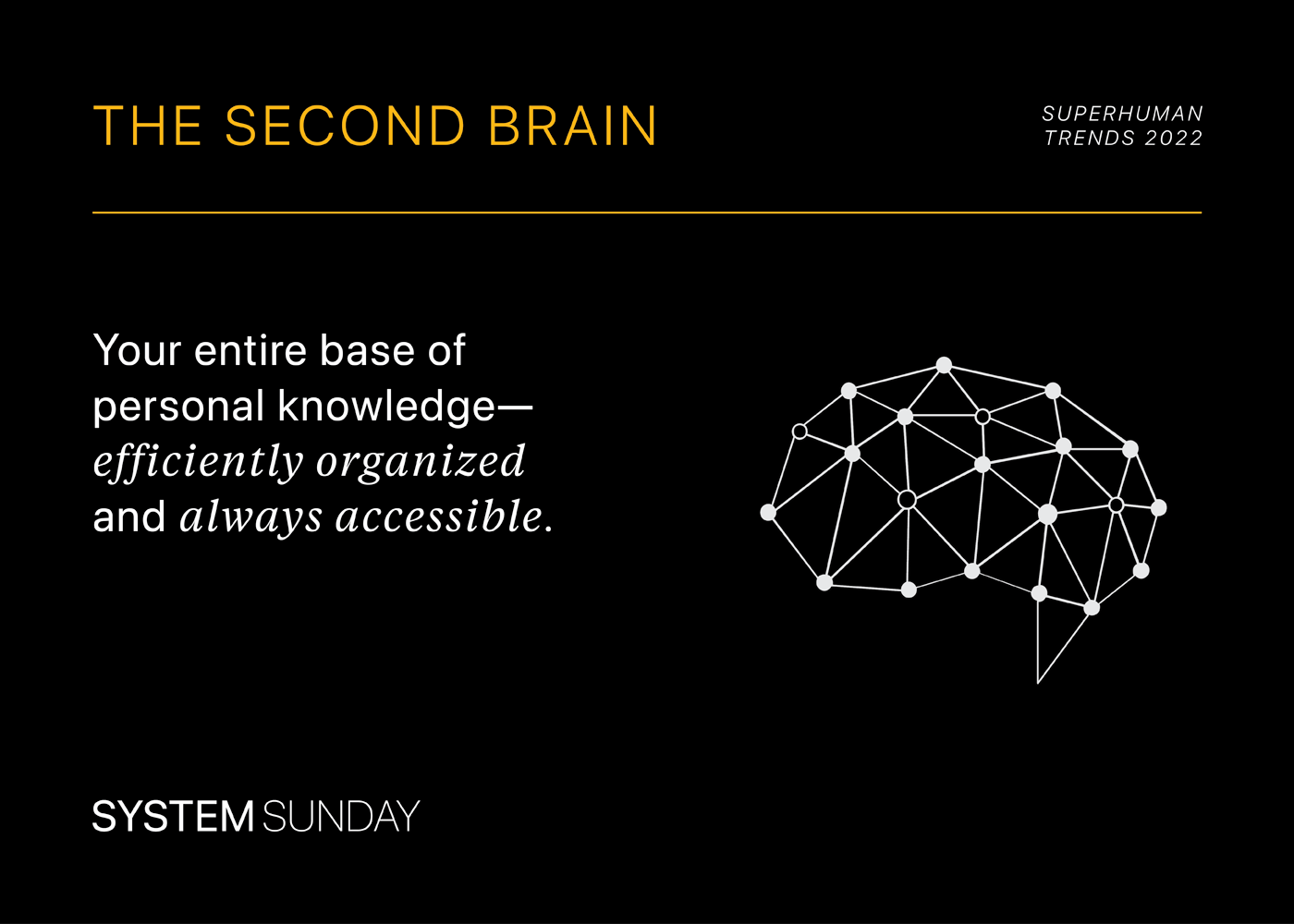
Key Insight
In July 2022, I’m predicting mass adoption of personal knowledge management systems. The reason? Tiago Forte—a leading productivity expert—will release his new book, Building a Second Brain.
Description
What’s a Second Brain? Imagine a system that captures and organizes all of your book notes, podcast notes, handwritten notes, photos, voice memos, etc. Your entire base of knowledge—efficiently organized and always accessible.
You may already be familiar with knowledge management at work, as I am. When I’m not writing at System Sunday, I’m an innovation consultant. My experience includes helping a large Fortune 50 bank establish a “knowledge base” for 250,000+ employees.
Knowledge Management is valuable because it allows organizations to store, retrieve, and apply complex information quickly—and that’s just for starters.
Know this: you, too, can realize breakthrough results by setting up your own personal knowledge base.
How You Can Benefit
Albert Einstein is famous for saying, “Never memorize what you can look up in books.” Einstein realized the importance of decluttering the mind to enable clear thinking. With a Second Brain, you can do just that.
Other benefits include:
- Capture your best ideas that might otherwise be lost
- Expand creative output by making new associations across learnings
- Discover peace of mind by having a trusted system
You’ve likely heard that applied knowledge is power. Well, the only way to use knowledge is first to capture, organize, and distill it. All possible (and made more efficient) by building a second brain.
Lessons from the Field
Building a second brain has been, perhaps, the single most valuable investment of my time. It’s where I store insights from virtual mentors, my original thinking, and life categories.
The how-to of my second brain is outside the scope of this trend report. That said, I'll share one critical node to bring the idea to life…
My second brain is interconnected with my learning system. First, I read on Kindle, where all my highlights are automatically digitized. After that, I simply transfer my highlights and annotations into Evernote. This process involves a convenient system of going back through the highlights/ annotations and copying the key takeaways into corresponding digital notebooks. You can access your device’s Kindle notes via Amazon or use software like Readwise.
In my second brain, I’ve created a cheat sheet for every life topic of interest to me—ranging from negotiation to the ketogenic diet. Only the best of the highlights enter my cheat sheets. This system is the 80/20 of learning and how I distill (what would be) information overload into wisdom/truths at my fingertips.
Are you beginning to imagine how a second brain might become your most prized possession?
Trend #2: Habitech
(Tech-Enabled Habits)
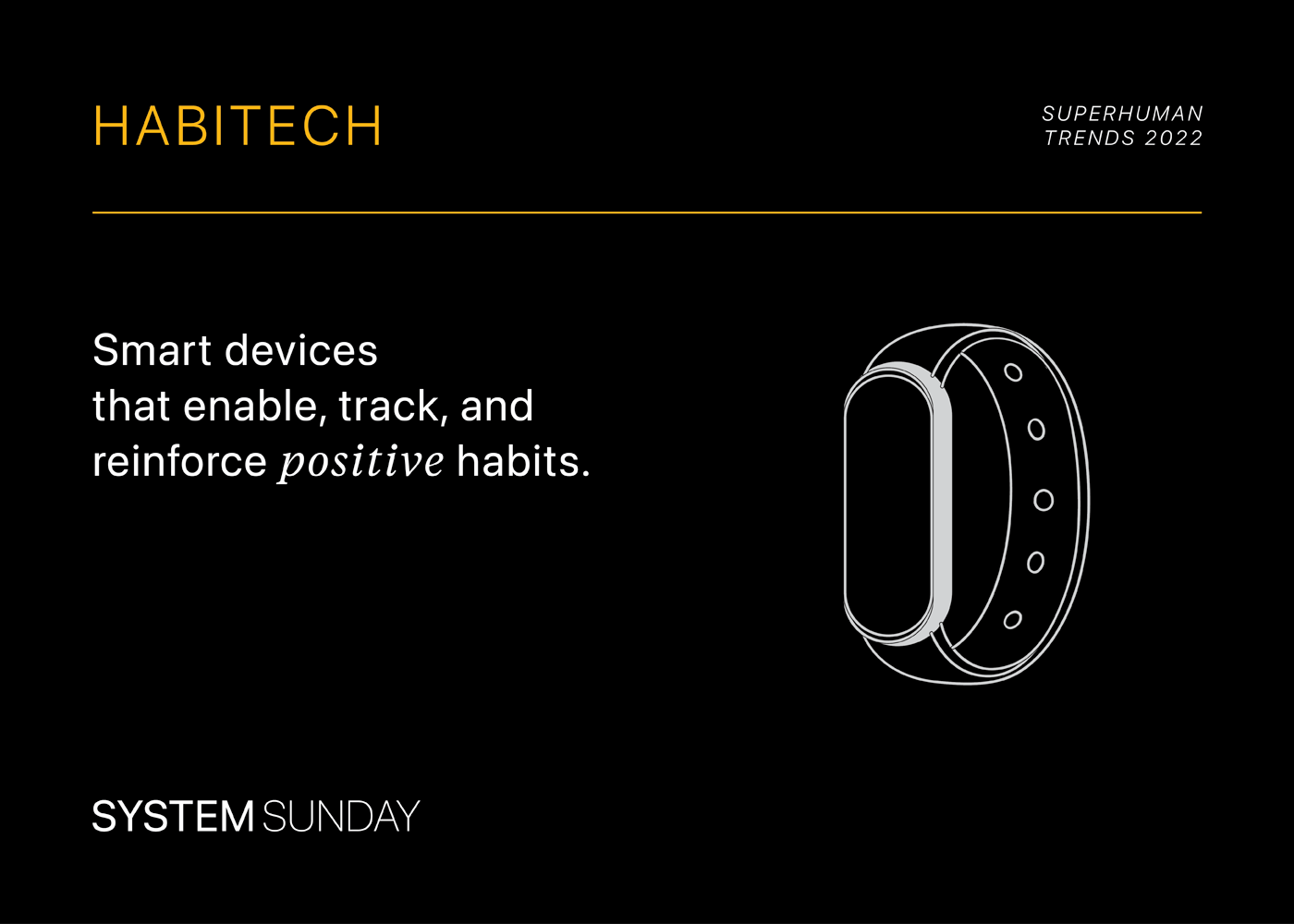
Key Insight
Look no further than some recent bestsellers to see that habits are core to self-improvement. My prediction: the next evolution of habit theory will be defined by tech-enabled devices.
The reason? Smart devices can enhance each stage of the habit-building process. Thus, a new moniker is required for this emerging theory of habit. Here, I introduce habitech to describe “smart devices that enable, track, and reinforce positive habits.”
Description
We all know that building good habits is downright desirable. So, the question is: what’s the easiest and fastest way to build good habits?
In his book Atomic Habits, James Clear introduces a helpful four-step process1:
- The 1st Law (Cue): Make it Obvious.
- The 2nd Law (Craving): Make it Attractive.
- The 3rd Law (Response): Make it Easy.
- The 4th Law (Reward): Making it Satisfying.
Now, I'd like to emphasize something here: tech-enabled devices can augment each of these steps.
Consider the positive habit of getting 7.5-8.5 hours of nightly sleep. Have you heard about Oura? The smart ring automatically tracks your total sleep, time in deep sleep, and efficiency of sleep (among other things).
Oura’s associated mobile app gamifies the sleep experience, providing a sleek dashboard and net score—out of 100—for your prior evening’s sleep performance.
Through Clear’s framework, let’s explore how habitech (using a smart device like Oura) enhances habit building:
| FRAMEWORK | HABITECH (EX: OURA RING) |
|---|---|
| The 1st Law (Cue): Make it Obvious. | The physical ring internalizes identity; the app notifies you that you’re approaching bedtime. |
| The 2nd Law (Craving): Make it Attractive. | Data-driven insights allow users to see and believe the connection between sleep and energy levels/performance. Users crave greater consciousness that results from rest. |
| The 3rd Law (Response): Make it Easy. | Users gain knowledge about which areas of sleep can be targeted for improvement: total sleep, efficiency, latency, deep sleep, etc. |
| The 4th Law (Reward): Make it Satisfying. | Gamified experience employs intuitive dashboard tracking. |
All finished? Here’s the takeaway: tech-enabled systems can upgrade the habit-building process, increasing the chances of solidifying your desired behavior.
Sidenote: Unfortunately, technology can also be deployed to enable and reinforce negative habits (see the documentary The Social Dilemma). At System Sunday, I aim to be vigilant about featuring only technology designed for personal growth.
How You Can Benefit
What's most interesting here is using technology to track performance automatically. Stick with me, because this is crucial…
Historically, people have avoided tracking and feedback because it takes too much time. Most people are too lazy (or too busy) and simply can’t be bothered. In the words of Kimberly “Sweet Brown” Wilkins: “Ain’t nobody got time for that.”2
Here is one area I see habitech taking personal development to an unprecedented level: providing people timely and accurate information with zero to minimal extra effort, and where the inevitable result is better decisions.
For example, say my Oura ring informs me that my body temperature is up +.9F and that my Heart Rate Variability (HRV) is outside my normal bounds. Without this knowledge, I might try to “power through” the day. Deteriorating my health further (and potentially sidelining me for multiple days). Instead, thanks to feedback from Oura, I can prioritize recovery and improve my odds of a speedy return.
The more strategic tech-enabled feedback loops you can build (running behind-the-scenes in your life), the more informed you will be. The more informed you are, the better decisions you will make. The better decisions you make, the more you will get paid. And the more you get paid, the more optionality you will have for freedom—in every life category. 3
Lessons from the Field
I used to be terrible at drinking water. Constantly dehydrated, I experienced ear-piercing migraines as the norm. At first, I didn't know the cause—I had no idea I wasn’t drinking enough water. (Turns out people tend to overestimate their abilities—even when it comes to fundamental life tasks.)4
But now that I’ve swallowed the proverbial “red pill”—learned about systems and finally saw the true nature of reality—I no longer, have to swallow the Advil pill.5
Now, I use a smart water bottle: HidrateSpark. In black steel. Less of a random hydration machine and more of a personal statement.
Bluetooth-enabled, and with an accompanying mobile app, HidrateSpark automatically tracks my daily water intake. Its mobile app gamifies the experience, showing a dial of current in-take vs. recommended pace. And like with Google Maps, you better believe I’m trying to beat that ETA!
Also, the bottle provides real-time feedback by occasionally glowing when users are behind pace. (I set my light to white, but you can turn this feature off entirely.) Many times the reminder of a subtle glow gets me back on track.
Once again, through Clear’s framework, let’s see how habitech (using a smart water bottle) can improve the habit-building process:
| FRAMEWORK | HABITECH (EX: HIDRATESPARK PRO) |
|---|---|
| The 1st law (Cue): Make it Obvious. | The water bottle’s subtle glow prompts action. |
| The 2nd law (Craving): Make it Attractive. | Sleek, minimalist design, personal statement; aligns with identity of being upgraded through tech. |
| The 3rd law (Response): Make it Easy. | A one-time bottle purchase helps lock in future behavior. |
| The 4th law (Reward): Make it Satisfying. | Gamified experience employs satisfying dashboard tracking. |
The bottom line: I’ve never been able to get my daily hydration under control. Until now. Until I had the help of an intelligent water bottle.
Know this: I don’t think I’m special. I’m just a regular guy with a particular set of systems. Weekly, I publish a newsletter to share my favorite habitech (like the HidrateSpark). Feel free to register below:
Trend #3: VR Upskilling

Key Insight
The Virtual Reality (VR) market size is $4.8B in 2021 and is expected to grow to $12B by 2024.6 While most think about Virtual Reality (VR) for games and movies, the opportunities for personal growth applications are virtually endless.
VR is not only a powerful tool for upskilling but also a game-changer for accelerating habit development. Why? Research shows that habit building is a function of frequency. Increasingly, people will use virtual reps to encode habits faster than ever before.
Description
Donald Hebb once said, “Neurons that fire together, wire together.” In other words, repetition reinforces pathways in the brain. The more we practice/experience a skill, the more internalized and effortless that skill becomes.
You see, practice allows us to achieve what researchers call “unconscious competence.”7 That is achieved when we no longer have to think about knowing the topic—like becoming fluent in a new language.
How does this relate to VR? Research shows that VR learning is more effective at accelerating “becoming” than any other form of media ever created (such as books, podcasts, and video).8
In the words of Jeremy Bailenson (the Director of the Virtual Human Interactions Lab at Stanford University):
VR feels real, and its effects on us resemble the effects of real experiences. Consequently, a VR experience is often better understood not as a media experience, but as an actual experience, with the attendant results for our behavior.
At this point, you might be wondering: why not just practice the skill in real life? It’s a great question. Now, consider that real-life experiences often come with time, money, location, energy, and risk/safety constraints, to name a few.
One way that last constraint—risk/safety—is being handled? Enter STRIVR, a VR application that helps both amateur and professional football players train in virtual simulations, allowing users to rapidly get reps and learn complex playbooks, all the while avoiding injury (in a notoriously dangerous sport).
The most significant promise of VR? The ability to give people access—while location-independent—to word-class instruction and experiences that create measurable change within. In other words: the ability to democratize psychologically powerful upskilling for humanity.
Am I being overdramatic? You might think so. But don’t kid yourself by overlooking VR. It’s a game-changer.
How You Can Benefit
High-performing athletes have long cited visualization as an effective training tactic.
For example, Michael Phelps, with goggles full of water, won the 200m Butterfly in the 2012 Beijing Olympics (incidentally, also setting a world record). After the race, a reporter asked what it had felt like to swim blind. Phelps’s answer? “It felt like I imagined it would.” 9
Well, if you’re anything like me, you may struggle with visualization…and fail to reap the benefits. VR solves that problem.
Standford’s Professor Bailenson agrees:
The mere act of thinking about an action, for instance, produces brain activity similar to what you’d see if the action were actually being performed. But that is only if the visualization is done the right way. The problem, of course, is that there is a high variability in how well people can visualize and put themselves in those situations. With VR, coaches and trainers can create visualizations for players. 10
The message is clear: in VR, users can be guided through a wildly effective visualization (with their eyes wide open).
Whether you’d like to practice public speaking, face a phobia, or engage in immersive language learning…VR personal growth experiences are rapidly emerging.
If you’re curious, Facebook’s Oculus Quest and Sony’s Playstation VR dominate the VR headset market. The two players make up nearly 60 percent of the market share (Facebook, 38.7, and Sony, 21.9).11 You can browse on-demand experiences in their respective app stores.
Lessons from the Field
Admittedly, my claim of accelerating everyday habits through VR may be a little premature. That said, I want to get this on your radar, because I think encoding habits with VR will be a big deal. Along with the broader category of habit-building IoT devices (habitech).
My obsession with accelerating habits started while reading James Clear’s Atomic Habits. One section, in particular, hit me like a ton of feathers (weighs the same as a ton of bricks):
“If you want to master a habit, the key is to start with repetition, not perfection,” says Clear. Then he goes on to say, “Habits form based on frequency, not time.”12
Key word there: frequency.
If habit development is a function of frequency, then, to accelerate habit development, we simply need to practice the habit. Much like building muscles through repetition, we can create a habit-encoded mind through repetition!
Hang in there. I know, it’s a lot of feathers.
Say you want to build a powerful morning routine of:
- Rising from bed immediately when your alarm sounds
- Waking up your mind/body with two minutes of jumping rope
- Drinking a full (smart) bottle of water
- Etc…
Practicing the entire routine in real life would be time-consuming, energy-draining, and impractical.
Now, imagine a VR application that guides you through a mental rehearsal of your desired routine—aligned to habit theory (cue, desire, action, reward). A program that cycles through virtual practice faster than a person could complete the steps in real life.
Users could record their desired habit (or habit stack), allowing them to rehearse the routine whenever and wherever they want virtually. Remember: VR is very effective at wiring and firing neurons—a.k.a. driving actual programming within.
The ability to practice habit(s) repeatedly—with less time, money, risk, etc.—could quickly supersede the benefits of real-life habit rehearsal. This technology would allow people to encode habits faster than ever before—and, ultimately, enable users to create upgraded versions of themselves in real life.
I’m not aware of anyone building this. Do you think fast-tracking habit development with VR is a good idea? If so, drop me a line on Twitter.
Trend #4: Exponential Energy
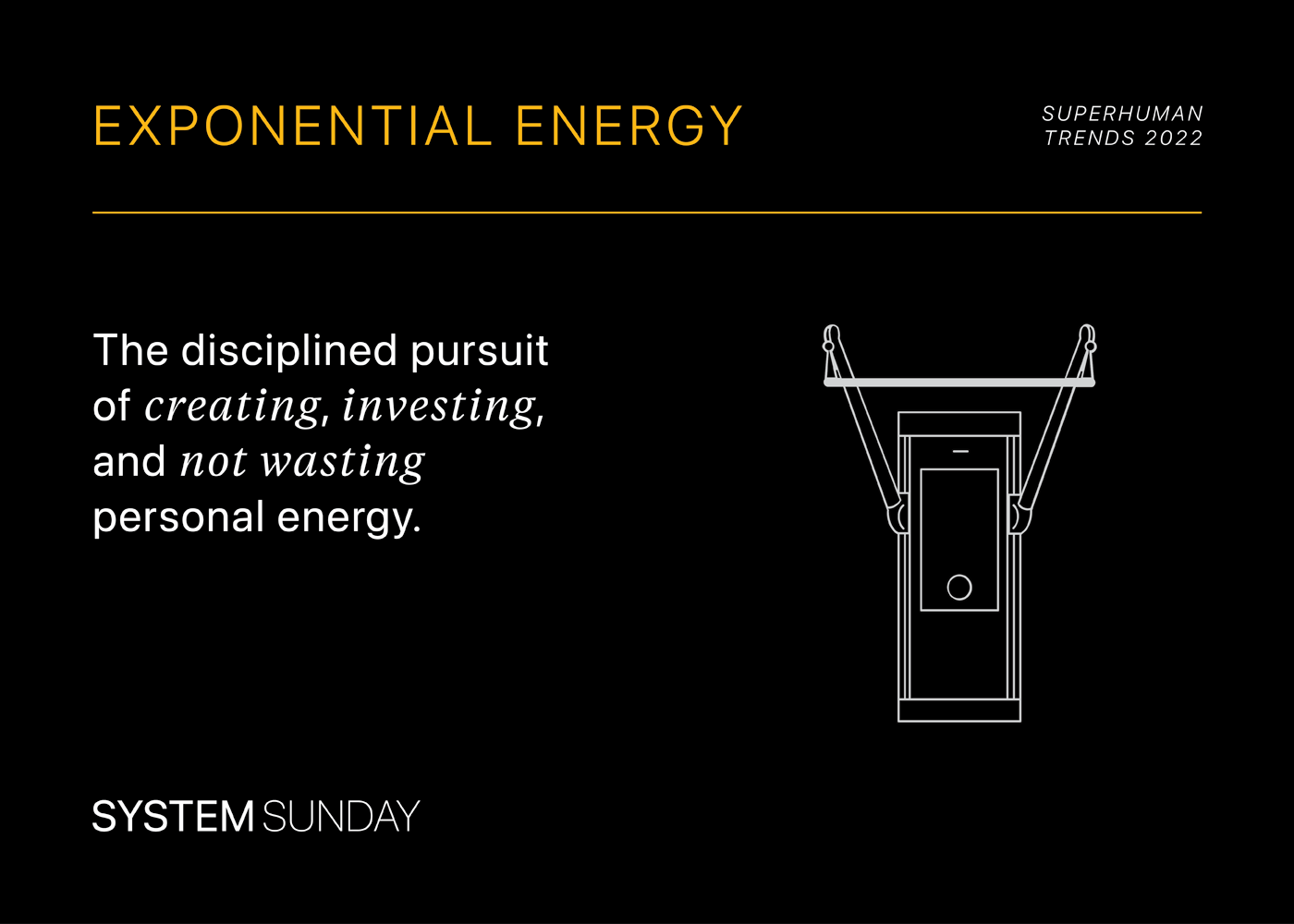
Key Insight
Published in 2003, The Power of Full Engagement was an instant best-seller. The book's main takeaway: managing your energy is more valuable than managing your time. Nearly 20 years later, thanks to technological advances, people have better tools to quantify (and optimize) their energy.
Description
Energy management without time management means potently working on the wrong things. Time management without energy management means impotently working on the right things.
The holy grail: When you combine time and energy management, you will be working on high-value activities at peak energy states…a recipe for flow.
A few breakthrough energy management technologies include:
- Oura Ring: track and measure sleep, heart rate, body temperature, activity levels, and more
- Food sensitivity tests: Kits from companies like Everlywell to see your body’s immune response to 96+ foods
- At-home high-intensity interval training (HIIT)—powered by tech-enabled equipment like Tonal, Peloton, and Mirror
How You Can Benefit
Being in a flow state is a great feeling. And can be highly productive.
Take McKinsey' s ten-year study, which found that executives are 500 percent more effective when in flow.
A leading author on flow, Steven Kotler, emphasizes, “This means, if you spend Monday in flow, you can actually take the rest of the week off and still get more done than your steady-state peers.”13
Unfortunately, the same McKinsey study found that most of us spend less than 5 percent of our work-life in flow.
Why? Well, the answer is simple: most people don’t strategically manage the factors that influence flow (like energy and time).
Often I see friends and clients doing low-energy tasks in peak energy states. You see, energy management is about “creating it, investing it, and not wasting it. 14
The following quote from Duke University Professor Dan Ariely advances this point:
One of the saddest mistakes in time management is the propensity of people to spend the two most productive hours of their day on things that don't require high cognitive capacity (like social media). If we could salvage those precious hours, most of us would be much more successful in accomplishing what we truly want.15
Now, let’s discuss how to create and sustain more energy.
Lessons from the Field
Disclaimer: While I am a NASM Certified Personal Trainer, I am not a licensed dietitian. The below information is based on a sample size of 1: my own experience.
My bet is the most successful people in the future will be those who strategically use technology to manage and direct their energy. Making technology a tool, and not the other way around.
It starts with aligning all of your personal systems to the purpose of energy optimization: fitness, nutrition, sleep, relationships, career, etc.
One common mistake I see is people with conflicting personal systems. For example, they want to have a bodybuilder’s physique and optimize for clear thinking (to excel in their knowledge-based career).
I sympathize. I used to consume a grueling amount of (lean!) protein to try and build muscle. Naturally, I’d be in a perpetual state of lethargy. This plan was like walking up a down-moving escalator.
You see, to achieve a sidewalk-cracking physique, bodybuilders regularly consume 10,000+ calories per day. Imagine the amount of energy that’s expended processing all that food! Bodybuilders make a massive sacrifice in their energy to look the way they do. (One reason I suspect mental health is a major issue in the sport.)
Another example of conflicting systems: imagine you’re an ambitious person in a relationship with someone who wants to live a more whimsical life. As a result of these misaligned values, your partner may inadvertently (or intentionally) make you feel bad for working hard, draining you of emotional energy. Again, trying to walk up a down-moving escalator.
Donella Meadows, the legendary systems thinker, sums up my point perfectly:
When a subsystem’s goals dominate at the expense of the total system’s goals, the resulting behavior is called suboptimization.16
Want to learn more about energy management? Check out my free ultimate guide on the topic.
Trend #5: LIFE SYSTEM BUILDING
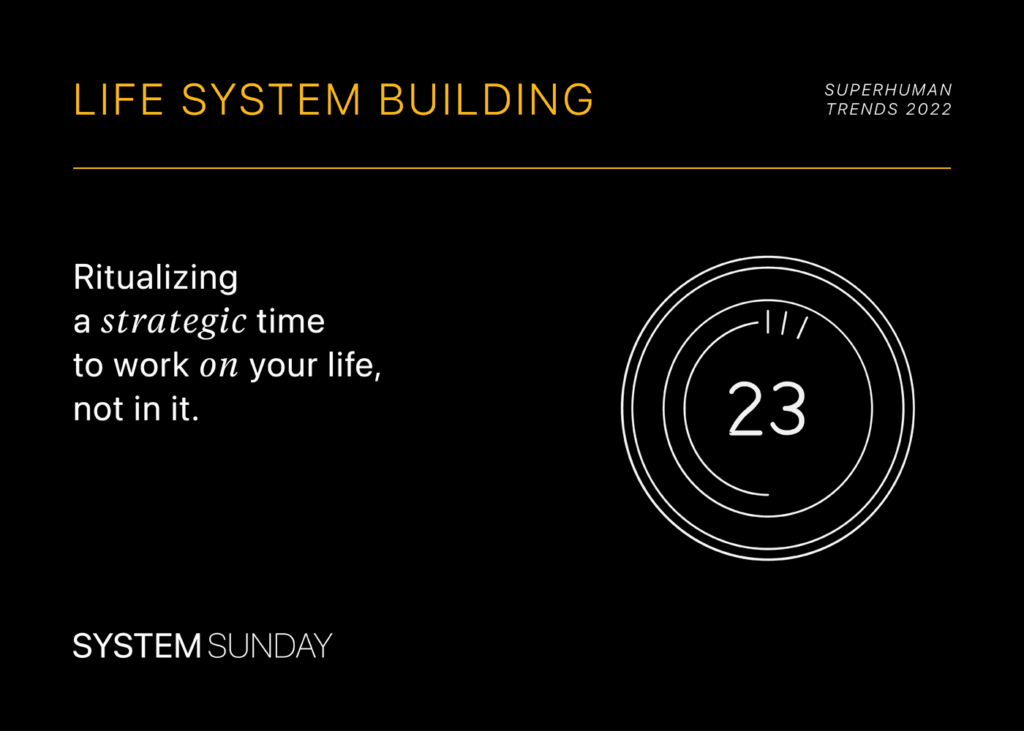
Key Insight
You can think of this one as a “meta-trend.” It enables you to implement all the other growth trends in this report. Launched in March 2022, System Sunday is my new blog that teaches people why systems are greater than habits (and which tech products enable the strongest systems). At the core of System Sunday is a weekly meeting with yourself: a time to get in “the lab” and systematically design the life you choose.
Description
In the words of James Clear, author of Atomic Habits, “You do not rise to the level of your goals. You fall to the level of your systems.”17
My question is, when do you actually create those “life systems”? In other words, how much time do you spend reviewing your habits (and whether they're working for or against you)? For most of us, it's zero.
Enter the System Sunday Method. A weekly one-hour session with yourself—broken down into two activities: review and optimize.
- Review (30 mins): First, we review how the prior week went through quantitative and qualitative reflection.
Quantitative: you'd be surprised how many data points about your life are already being tracked…your step count, your phone pickups, etc. Imagine reviewing those regularly to spot trends over time. Now imagine automating even more interesting data through new tech products (like sleep quality, hydration, etc.). System Sunday gathers the most game-changing products to do just that. Check out these seven metrics.
Qualitative: Based on the quantitative results, I jot down my qualitative reflections in a journal. For example, perhaps I noticed that I didn’t hit my meditation target of ten minutes per day. I’d note the gap in performance and reflect on how this impacted my energy, mood, focus, etc. - Optimize (30 mins): Next, we figure out how to improve our performance in the coming week. Here we use systems thinking to identify the levers for growth. That’s how we address slipping performance and do more of what's good for us.
Again, take my previous example of missing my meditation target. In the optimization phase, I’ll consider the root causes of why I didn’t meditate as much as I’d have liked. Was it a mental model issue (like a slip in motivation because I wasn’t feeling any direct “impact”), a structural issue (like a failure to block out time in my calendar), or both? The key here: take the next step that gets you back on track.
Say it was a structural issue—I might set up a daily calendar invite at the same time as my alarm (and put my phone on Do Not Disturb at night), so it’s the only thing I see the next morning.
“Optimize” is also the step where you discover products to upgrade your systems. For example, I bought a subscription to the Waking Up app created by Sam Harris to better structure and track how frequently I was meditating. You can discover the best products and technology in the free System Sunday newsletter, which showcases a cutting-edge product every—you guessed it—Sunday.
How You Can Benefit
As a famous quote (often erroneously attributed to Abraham Lincoln) tells us: “Give me six hours to chop down a tree and I will spend the first four sharpening the ax.”
The weekly System Sunday meeting with yourself is how we sharpen the ax. It’s ritualizing a time to work on your life, not in it. More than a step-by-step process, System Sunday is an ethos for taking care of your future self.
My mission is to help people see the value of strategic planning. So you can go from anxious and uncertain to confident and in control. If there’s only one idea for you to take away from this entire report, may it be this: to give yourself the gift of strategic time. Whether you choose to invest some of that time with me at System Sunday is entirely your decision.
Lessons from the Field
For nearly four years, I’ve kept the weekly calendar date with myself, “System Sunday.”
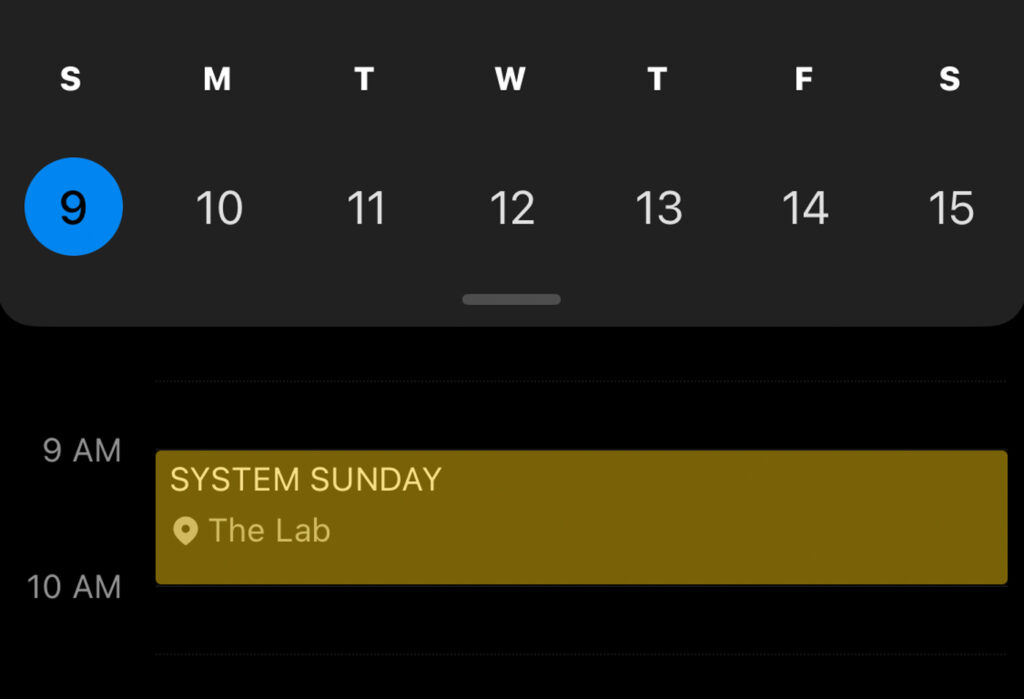
The results have been life-changing. You can learn more about my journey here.
Trend #6: Smart Environment Design
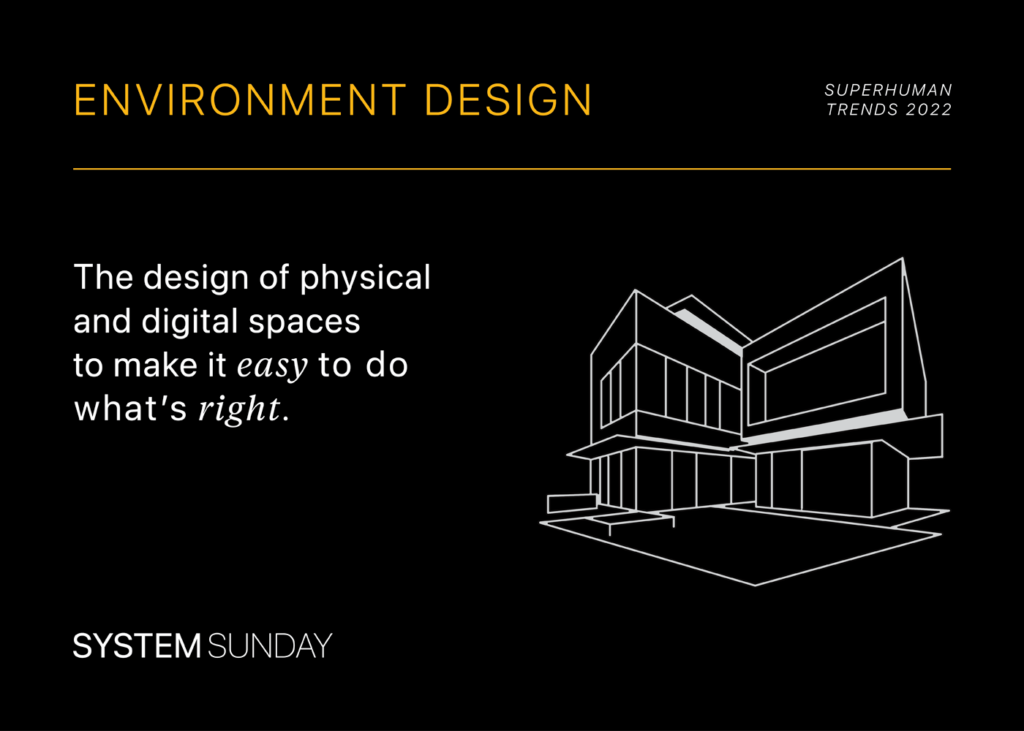
Key Insight
James Clear, author of Atomic Habits, writes, “Environment is the invisible hand that shapes human behavior.”18 Clear teaches that people often overvalue the roles of motivation, talent, and effort in building habits. In reality, the highest point of behavioral change leverage—and path of least resistance—is intentional environment design.
Description
I like this question from Clear: “How can we design a world where it’s easy to do what’s right?”19
Environment design begins with thinking about your environment in terms of relationships and interactions. What’s most interesting here is that person-to-environment interactions occur at each of the five human senses.
So get this: people can design highly-productive environments by optimizing each sensory category.
OK, here’s what I’m talking about:

A lot of possibilities. Now, let’s talk about the benefits…
How You Can Benefit
People can thoughtfully curate their person-environment interactions to be more productive than they ever thought possible.
Realize that—at any moment—our experience is the product of our senses. Key word there: product.
And by stacking positive sensory interactions, you can create a force multiplier for productivity. On the other hand, if any sense is genuinely out of whack (a zero on the scale), it will undoubtedly affect your productivity. Think jackhammer right outside your window.
And the rule of multiplying by zero tells the outcome: Any number, no matter how large, multiplied by a zero, is a zero.
Mental toughness and willpower are important. But if you can optimize each sensory function in your curated environment, wouldn’t that be the easier, smarter path?
Lessons from the Field
During the pandemic, I bought a mountain home in Vermont. Moving was an excellent opportunity to clear the closet (literally) and design a more thoughtful home environment.
Admittedly, I sacrificed a lot leaving NYC. Proximity to close friends, access to world-class cultural events, and banana bread pudding from Magnolia. But the upside of designing my dream home environment has surpassed my expectations.
Here are some of my learnings—for each of the five senses:
- Vision: One powerful vision tactic is to mimic outdoor lighting in indoor spaces—by using blue lights. Research shows the blue lights suppress melatonin, a chemical that makes us sleepy.20 In other words, people can use daylight blue to stay awake.
Increasingly, individuals (and companies) are optimizing their workspace lighting to boost energy levels. I strategically use blue light in the mornings and through the early afternoon to stay alert. I’ve installed blue lighting throughout my home office.
Alternatively, I switch my home office to “red light” around 5 PM (to avoid the negative impact on my sleep). Keep in mind that electronic devices also emit blue light. I use Flux App on my desktop and the “Night Shift” setting on my iPhone to filter out blue light in the evening.
Sidenote: More and more biohackers wear blue-light blocking glasses as they wind down their day. I’ll be experimenting with these in the coming year to further optimize for deep sleep.
- Sound: Scoring your day is a great tactic to elevate your mood and encourage focus. Who else here loves the hypnotic ambiance that resonates throughout spas and resorts? I’ve recreated that feeling in my home with Sonos One speakers—powered by Bluetooth 5 technology.
For music, I recommend focus@will. But my favorite Spotify playlist when I need to get shit done: Pirates of the Caribbean. Weird? Perhaps. Effective? Absolutely.
- Touch: There’s a quote from the documentary Minimalism that I try to live by:
By purchasing fewer things and going for higher quality, you’ll declutter your environment, limit decision fatigue, and derive more utility from each of your possessions. What we own becomes an extension of who we are. So, if we’re going to possess something, shouldn’t we at least appreciate it?We are too materialistic in the everyday sense of the word, and we are not at all materialistic enough in the true sense of the word. We need to be true materialists, like really care about the materiality of goods.21
- Taste: I’m a big fan of drinking Bulletproof Coffee throughout my morning “deep work” time block. Often referred to as “butter coffee,” Bulletproof boosts my cognitive function by fueling my brain with the essential fats it requires to operate at its best. My Bulletproof potion of choice? Ghee, MCT Oil, and Nespresso (for convenience). Aside from Bulletproof, I typically intermittent-fast from 7 PM to 10 AM. The goal: delay energy-draining digestion until I finish my most important “deep work” task for the day.
- Smell: Author and performance coach Christopher Bergland shares, “The scents that you surround yourself with are in the locus of your control. You can put yourself in the driver's seat, and use fragrance as a tool to create a particular mindset and increase your motivation to achieve a target behavior.”22
You can take advantage of scent by using an aromatherapy diffuser, which can be very powerful in creating a productive state. From Jim Kwik’s book, Limitless, I learned that peppermint and lemon promote concentration.23 As I’m writing this, my Vitruvi Diffuser is exhaling geranium (which is known to have a unique effect of both calming and stimulating). As for the essential oils, I like the brand Doterra.
Environment design is fun, isn’t it? The bulletin: by taking a design-first mentality in shaping your life, you’ll be able to engineer more empowering sensory outcomes. Leading to both productivity and greater happiness.
Can't get enough of environment design? Dive deeper in my free ultimate guide.
Recap: Superhuman Trends 2022
Passengers, please put your tray table in the upright position for landing!
We’ll finish with a recap of the six tech trends set to transform personal development in 2022:

Which tech trend (listed above or otherwise) are you most excited about in the coming year? Let me know on Twitter.
One final thing: if you enjoyed my first annual Superhuman Trends report, please share it with others.
Share this report on Twitter, Facebook, LinkedIn, Text, or via email.
Cheers—here's to your personal innovation in 2022!
Footnotes
- Atomic Habits by James Clear, p.54.
- Ain’t Nobody Got Time for That, featuring Kimberly “Sweet Brown” Wilkins.
- This line of thought is inspired by The Almanack of Naval Ravikant by Eric Jorgenson. Chapter: “Building Judgment,” p. 105.
- “The Superiority Illusion: Where Everyone is Above Average,” Scientific American.
- Sam Carpenter, in Systems Mindset (Chapter 36), relates adopting the systems mindset to taking the “red pill,” a movie reference to The Matrix. In The Matrix, Neo (played by Keanu Reeves) is given a choice between swallowing a blue pill and remaining in an illusion or swallowing a red pill and seeing the true nature of reality.
- Statista, “Virtual reality (VR) — Statistics & Facts” by Thomas Alsop.
- “Four Stages of Competence,” Wikipedia.
- Experience On Demand by Jeremy Bailenson, Chapter 2, Location 629.
- The Power of Habit by Charles Duhigg, Mike Chamberlain, et al, p. 115.
- Experience On Demand by Jeremy Bailenson, Chapter 1, Location 524.
- Statista, “Virtual reality (VR) headset shipment share 2nd quarter 2020, by Vendor” Lionel Sujay Vailshery.
- Atomic Habits by James Clear, pp. 142 and 145.
- “Create a Work Environment That Fosters Flow” by Steven Kotler, Harvard Business Review.
- Limitless: Upgrade Your Brain, Learn Anything Faster, and Unlock Your Exceptional Life by Jim Kwik, p. 110.
- 15 Secrets Successful People Know about Time Management by Kevin Kruse, Chapter 2, Location 493.
- Thinking in Systems by Donnella H. Meadows, p. 84.
- Atomic Habits by James Clear, p. 27.
- Ibid., p. 81.
- Ibid., p.158.
- “Why Paying Attention to This Overlooked Office Feature Might Have a Huge Productivity Payoff” by Kevin J. Ryan.
- Minimalism: A Documentary About Important Things, Quote by author and sociologist Juliet Schor.
- “How Does Scent Drive Human Behavior?” by Christopher Bergland, Psychology Today.
- Limitless: Upgrade Your Brain, Learn Anything Faster, and Unlock Your Exceptional Life by Jim Kwik, p. 201.